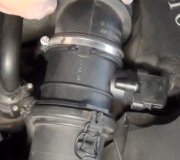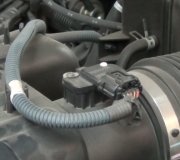Try the following diagnostic tests to see if you can come up with anything.
DTC P0101: MAF SYSTEM PERFORMANCE
Circuit Description
Mass Airflow (MAF) sensor measures amount of air entering engine during a given time. PCM uses MAF sensor information for fuel delivery calculations. MAF sensor readings during acceleration are much higher than those during deceleration or idle.
PCM calculates what MAF sensor reading should be when received from sensor under certain conditions using engine speed (RPM), throttle position, and barometric pressure parameters. When certain test conditions are met, PCM will compare its calculated MAF value to actual value received from sensor. If difference is too great, DTC will set.
For duplication of DTC, ensure:
� Engine is running.
� System voltage is 9-18 volts.
� Throttle angle is steady and less than 30 percent.
�
EGR duty cycle and pintle position less than 100 percent.
� MAP and TP sensor values are steady.
� EVAP canister purge less than 100 percent.
These conditions must be present for a predetermined amount of time.
Diagnostic Procedures
1. Perform On-Board Diagnostic (OBD) system check. After performing OBD system check, go to next step.
2. If any other DTCs are set, diagnose these DTCs first. If no other
DTCs are set, go to next step.
3. Turn ignition on, engine off. Using scan tool, read and record FAILURE RECORDS data. Operate vehicle within conditions noted in FAILURE RECORDS data. Using scan tool, monitor SPECIFIC DTC info for this DTC. If scan tool indicates this DTC FAILED THIS IGN, go to next step. If scan tool does not indicate this DTC FAILED THIS IGN, see
DIAGNOSTIC AIDS.
4. Turn ignition on. Observe MAP and BARO values on scan tool. If scan tool reads 65-105 kPa, go to next step. If scan tool does not read 65-105 kPa, go to step 8.
5. Start engine. Observe MAP sensor display on scan tool with engine idling. If scan tool reads 29-48 kPa, go to next step. If scan tool does not read 29-48 kPa, go to step 7.
6. Using scan tool, observe MAP sensor value while slowly increasing engine speed to 3000 RPM. If MAP sensor value increases as engine RPM increases, go to step 9. If MAP sensor value does not increase with engine RPM, go to step 8.
7. Check for throttle body inlet screen blockage. Check for vacuum leaks at intake manifold, throttle body, or EGR valve flange and pipes. Check for PCV valve faulty, missing or incorrectly installed. Check for skewed or unresponsive MAP sensor. Repair as necessary.
After repairs, go to step 22. If no problems are found, go to step
9.
8. Replace MAP sensor. After repairs, go to step 22.
9. Turn ignition on. Ensure throttle is closed. Using scan tool, read THROTTLE AT IDLE. If scan tool indicates YES, go to next step. If scan tool does not indicate YES, diagnose using DTC P0121.
10. Turn ignition off. Disconnect MAF sensor connector. Turn ignition on. Using DVOM, measure voltage between chassis ground and signal circuit at MAF sensor harness connector. If voltage is about 5 volts, go to next step. If voltage is not as specified, go to step 12.
11. Connect a test light between ignition feed circuit and ground circuit at MAF sensor harness connector. If test light illuminates, go to step 15. If test light does not illuminate, go to step 14.
12. If voltage is less than 4.5 volts, go to step 16. If voltage is not as specified, go to next step.
13. Turn ignition off. Disconnect PCM harness connectors. Turn ignition on, with engine off. Using DVOM, measure voltage between chassis ground and signal circuit at MAF sensor harness connector. If voltage is about zero volts, go to step 21. If voltage is not as specified, go to step 19.
14. Connect test light between chassis ground and ignition feed circuit at MAF sensor harness connector. If test light illuminates, go to step 17. If test light does not illuminate, go to step 18.
15. Check for faulty connection at MAF sensor. Repair as necessary. After repairs, go to step 22. If connection is okay, go to step 20.
16. Check for open or short in MAF sensor signal circuit between PCM and MAF sensor. Repair as necessary. After repairs, go to step 22. If signal circuit is okay, go to step 21.
17. Locate and repair open in MAF sensor ground circuit. After repairs, go to step 22.
18. Locate and repair open in MAF sensor ignition feed circuit. After repairs, go to step 22.
19. Locate and repair short to voltage in MAF sensor signal circuit. After repairs, go to step 22.
20. Replace MAF sensor. After repairs, go to step 22.
21. Replace PCM. Program replacement PCM using required equipment. After repairs, go to next step.
22. Turn ignition on, engine off. Using scan tool, read and record FAILURE RECORDS data. Clear DTCs. Start engine and operate vehicle within conditions noted in FAILURE RECORDS data. Using scan tool, select SPECIFIC DTC INFO for this DTC. If scan tool indicates that this DTC FAILED THIS IGN, go to step 2. If scan tool does not indicate that this DTC FAILED THIS IGN, system is okay.
Diagnostic Aids
Check for skewed or stuck Throttle Position (TP) sensor. Using scan tool, read TP ANGLE value with throttle closed. If value is not zero percent, check for and repair the following condition(s):
� Throttle plate sticking or excessive deposits on throttle plate or throttle bore.
� TP sensor signal circuit shorted to voltage.
� Faulty connection or high resistance in TP sensor ground circuit.
If none of the listed conditions exist and TP ANGLE value is not zero percent, replace TP sensor.
Check for faulty connections or damaged harness. Ensure harness is not routed too close to high-voltage wires, such as spark plug cables. If connections and harness appear okay, observe scan tool while moving all related harness and connectors. A change in scan tool display indicates fault location.
Check for plugged intake air duct or dirty air filter. A wide-open throttle acceleration from a stop should cause MAF reading on scan tool to increase from about 4-7 grams per second at idle to 100 grams per second or greater at time of 1-2 shift. If MAF reading on scan tool does not increase, check for restriction.
Check for a skewed MAP sensor, which can cause Barometric (BARO) pressure reading to be incorrectly calculated. This condition may also cause high Idle Air Control (IAC) counts. If IAC counts are high, replace MAP sensor.
Friday, December 31st, 2010 AT 11:56 AM



